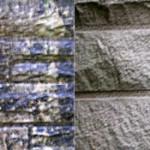 I’ll bet that most people will never know that they have mold within the masonry system of their home… until it is to late. Why? Well the effect is so gradual and occurs over such a long period of time that no one notices the change as it is occurring.
I’ll bet that most people will never know that they have mold within the masonry system of their home… until it is to late. Why? Well the effect is so gradual and occurs over such a long period of time that no one notices the change as it is occurring.However to the trained professional this problem is usually obvious and can cause damage to your masonry walls which lead to unnecessary repairs. If you can identify this problem before it causes damage to your wall system, you may save yourself some hard earned cash!
Stand back from the wall in question maybe 50’ to 75’. Now very casually begins to scan the wall. Do not focus on any given area but just look at the entire wall. You will notice the over all tonal quality to your masonry, in terms of light and color. Every wall is different depending on its location, whether it faces the prevailing winds or not and if the wall gets plenty of sunshine, so you must look at each wall individually.Ok.
Now that you have the over all color tone in your mind eye let’s take a little closer look. Notice the top portion of the wall in particular or where adjoining walls meet this wall. What you are looking for is a gradual darkening of the wall from the top down usually. It may not be obvious so you want to look for darker areas within the tonal range of the wall. If you identify an area that has this darkening effect, then step a little closer for a good visual and to see if you can figure out why that area is darker.
You will notice that directly above the darker portion of the wall will be a shed point of water, such as a termination point for an adjoining wall, roof, masonry or flashing materials. You have to look close and use your ‘inspector’ glasses because sometimes it may not be obvious. One thing is for sure. The wall would not be darker if there was no mold present.
That is your key to knowing that excessive water is entering into your wall system. Once you have identified the mold areas and the probable cause of the water infiltration then it’s a simple matter to fix the problem.
Many different repairs could be required depending on the cause, the location and the severity of the problem. Generally it will be flashing, a simple pointing of missing mortar joints, replacing a chimney crown or rebuilding portion of a damaged area.
As you can see there is no ‘one fix’ for any given mold problem. If the problem seems larger than you want to tackle then contact your local masonry repair expert for his advice, on how to prevent mold build up in your masonry walls.
























